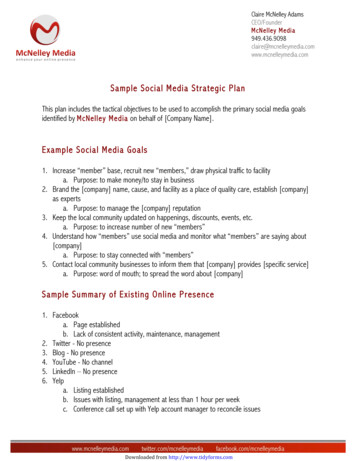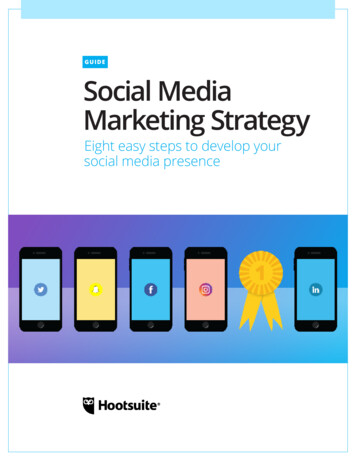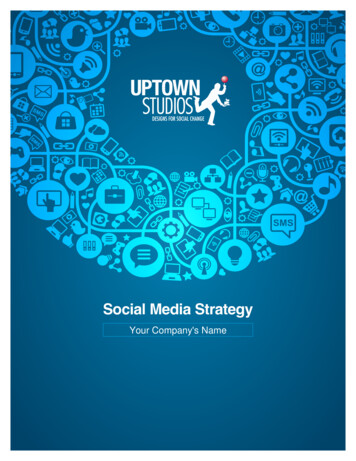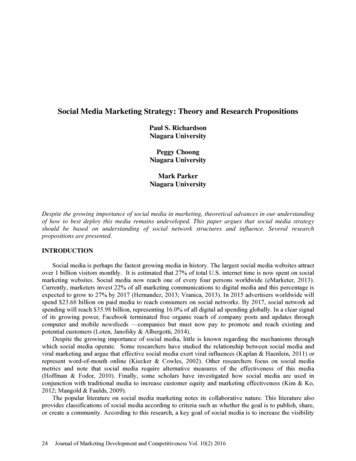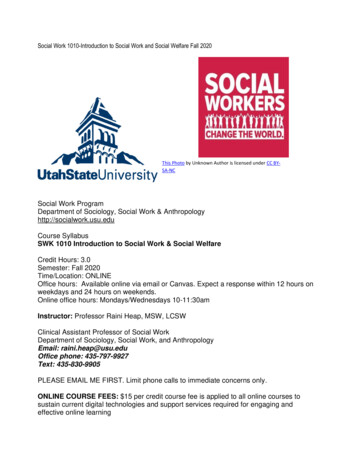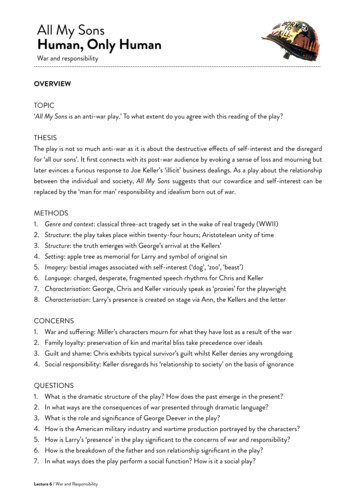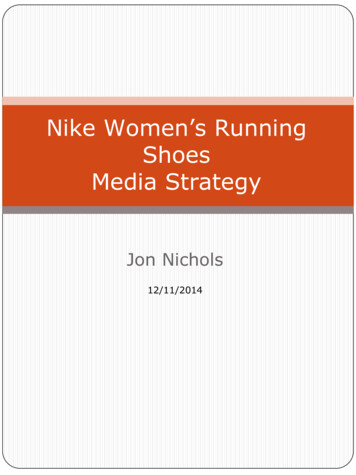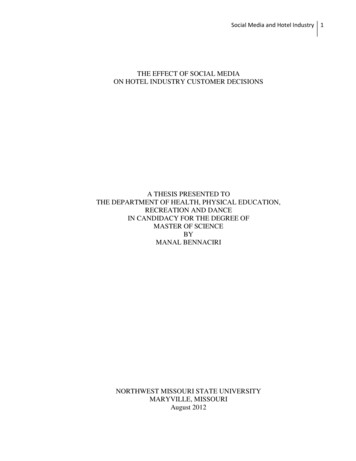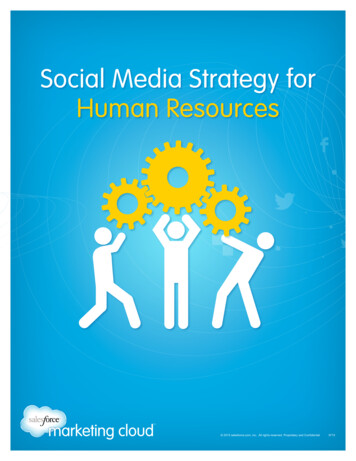
Transcription
Social Media Strategy forHuman Resources 2013 salesforce.com, inc. All rights reserved. Proprietary and Confidential 0713
Social Media Strategy for Human ResourcesTable of ContentsIntroduction. . . . . . . . . . . . . . . . . . . . . . . . . . . . . . . . . . . . . . . . . . . . . . . . . . . . . . . . . . . . . . . . . 3Chapter 1Showcase Your Company. . . . . . . . . . . . . . . . . . . . . . . . . . . . . . . . . . . . . . . . . . . . . . . . . . . . 4Chapter 2Find Candidates. . . . . . . . . . . . . . . . . . . . . . . . . . . . . . . . . . . . . . . . . . . . . . . . . . . . . . . . . . . . . 7Chapter 3Screen Candidates . . . . . . . . . . . . . . . . . . . . . . . . . . . . . . . . . . . . . . . . . . . . . . . . . . . . . . . . . . 11Chapter 4Train Employees. . . . . . . . . . . . . . . . . . . . . . . . . . . . . . . . . . . . . . . . . . . . . . . . . . . . . . . . . . . . . 13Chapter 5Implement a Social Media Policy. . . . . . . . . . . . . . . . . . . . . . . . . . . . . . . . . . . . . . . . . . . . . 15Chapter 6Connect Employees . . . . . . . . . . . . . . . . . . . . . . . . . . . . . . . . . . . . . . . . . . . . . . . . . . . . . . . . . 17Wrapping Up. . . . . . . . . . . . . . . . . . . . . . . . . . . . . . . . . . . . . . . . . . . . . . . . . . . . . . . . . . . . . . . . 21 2013 salesforce.com, inc. All rights reserved. Proprietary and Confidential http://www.salesforcemarketingcloud.com/2
Social Media Strategy for Human ResourcesIntroductionIn 2010, only 6% of companies were using social media for recruiting.Today, that’s exploded to 89%.The young, educated, and tech-savvy people you’re keen to have join your company are highly activeon social media. If you want them to join you rather than your competitor, you’ll need to be pretty skilledon social media yourself.You’ll need a social media strategy to differentiate your organization from everyone else vying forapplicant attention through LinkedIn, Facebook, Twitter, blogs and many other channels.Social media doesn’t stop being useful once you’ve hired someone. We’ll explain how to trainemployees to use social media, how to craft a social media policy, and how connecting and celebratingemployees can boost productivity and retention.After reading this ebook, you’ll have all the information you need to create or augment a social mediaplan for your human resources program. 2013 salesforce.com, inc. All rights reserved. Proprietary and Confidential http://www.salesforcemarketingcloud.com/3
Social Media Strategy for Human ResourcesChapter 1Showcase Your CompanyWhat truly great candidates really want is not just a paycheck but theopportunity to do meaningful work in an enjoyable environment.Before you even begin using social media to promote jobs and find candidates, think about how youare showcasing your company. What impression will candidates get when they look at your corporatewebsite and social profiles?Showcase Your WorkEvery human being has a deep desire to be part of something greater than themselves: a team ofsuperheroes out changing the world together. Does that sound like your company?Take a second look at the marketing materials that promote your company. Every press release, productpage, and case study you share isn’t just for potential customers: potential employees are looking atthem as well. Are you missing opportunities to brag about the neat things your company is doing?Encourage people throughout your organization to pass on stories about your company’saccomplishments. Make a note of what your employees find compelling enough to share and the anglethey’re taking; that list may not be identical to what your marketing department is promoting.Package up that kind of material in ways that are bite-size, easily shareable, and in a variety of media.We all have our own learning styles, so showcase your work in blog posts, video tours, interviews,ebooks, and so forth.Showcase Your PeopleYour employees are the heart and soul of your brand. People will form a stronger connection with you ifthey have a connection with your team members.One way to showcase the employees representing your brand is to include them on your “About Us”page. You may choose to showcase just your top-level executives, your community team or the entirecompany. Regardless, your “About Us” page should show off your company’s culture and personality. Itshould support the relationships you’re trying to build online using social media.The Berlin-based developers of the Wunderlist app introduce all 11 team members on the same page,creating a happy impression of both teamwork and individuality. A playful photo of each person in theirunique role illustrates a tight bio that manages to capture both their personality and contribution. 2013 salesforce.com, inc. All rights reserved. Proprietary and Confidential http://www.salesforcemarketingcloud.com/4
Social Media Strategy for Human ResourcesImage source: 6wunderkinder.com/about/Now look at your own “About Us” page. Will it inspire visitors to initiate a relationship with you on socialmedia? How will your clients and prospects feel about you after reading it? Are you dull gray — orsparkling with color?Celebrate individual employees. Demonstrate you’re offering what we all crave: recognition for a job welldone. Southwest Airline’s Career page highlights their Star of the Month. 2013 salesforce.com, inc. All rights reserved. Proprietary and Confidential http://www.salesforcemarketingcloud.com/5
Social Media Strategy for Human ResourcesUPS celebrated employee Ron Sowder driving their trucks for 50 years without an accident. And theydid it in style:Before crossing the finish line Wednesday atUPS’s facility in West Carrollton, Ohio, just southof Dayton, Ron was escorted for the last few milesof his milestone trip by Ohio State Troopers. Hewas then greeted by a blast of confetti and anenthusiastic welcoming committee at the building.Who wouldn’t love to be part of that team?Share employee success stories onFacebook, interview them on YouTube, andlink to their Twitter feeds. Team members whouse social media well (read on to learn how totrain them) will bring in great applicants.Showcase Your CultureYour company culture should be a vital part of your recruiting strategy. Online shoe retailer Zappos gets1000 applicants for every position they advertise. Why? Their zany and delightful corporate culture.How many other companies have their own music video?YouTube, Facebook, Pinterest and Flickr are ideal outlets to show off all the reasons your employeeslove working for your company. There’s nothing so powerful as exuberant employees raving about thegreat time they’re having working for you.Is your campus located in the middle of a vibrant city? Do you give your employees time off every yearto volunteer with their favorite causes? Is there a log-rolling competition at your annual picnic? Capturethose experiences and work them into your social mix.Your company’s attitude toward social media itself can play an outsize role. According to Cisco’s 2011Connected Technology World Report, almost half of young professionals and college students wouldchoose unrestricted access to social media atwork over a higher salary. Cisco’s report foundthat 40% of college students and 45% of youngprofessionals would accept a lower-paying jobthat offered more freedom to use social mediaand mobile devices.How your company promotes (or restricts)social media says a great deal about yourculture and how much you trust youremployees. 2013 salesforce.com, inc. All rights reserved. Proprietary and Confidential http://www.salesforcemarketingcloud.com/6
Social Media Strategy for Human ResourcesChapter 2Find CandidatesFind Candidates on LinkedInLinkedIn is the world’s largest professional network, with over 175 million members (as ofAugust 2, 2012) and rising fast. Eighty-five of the Fortune 100 use its corporate hiring solutions.It’s much more efficient than wading through job boards and much more cost-effective than hiring othersolutions.Start by building up your own referral network of people who may be candidates themselves or canrecommend candidates. Connect with current clients, industry experts, and current and formeremployees. Join relevant LinkedIn Groups to establish yourself as an expert, raise your profile, and findqualified professionals who are influential in your industry. (For your own growth, join and engage inLinkedIn groups dedicated to HR professionals, especially in your industry.)LinkedIn charges US 195 to post a job for 30 days (though the price varies slightly based on area). Youcan also purchase ads targeted directly at professionals specified by your criteria.Only 21% of working professionals around the world are looking for a new job. The other 79% areconsidered passive candidates. LinkedIn Recruiter allows companies to reach qualified passivecandidates by searching the entire network based on location, industry, skill set and other keywords.Management consultant Susan Heathfield recommends:Ask your current employees to activate their networks to reach out to potential passive candidates forjobs (Not everyone is looking, but most people are open to discussing the right opportunity). Employeereferrals are valued because most employees will only refer to you people with whom they want to work. 2013 salesforce.com, inc. All rights reserved. Proprietary and Confidential http://www.salesforcemarketingcloud.com/7
Social Media Strategy for Human ResourcesLinkedIn Career Pages are “a home on LinkedIn to highlight your jobs, feature employees, and buildyour employment brand.” Take a look at what Google, BP and 3M are doing with theirs. Here’sSalesforce.com’s:Find Candidates on FacebookFacebook’s 1 billion active users (as of October 4, 2012) makes it by far the largest network availableto any recruiter. 48% of all job seekers do social media job hunting on Facebook. So not only are yourideal candidates already on Facebook, there’s a good chance they’re using the network to find theirideal employer.Since so many Internet users spend so much time on Facebook, many candidates’ first encounter withyour brand may be on your Facebook page, not your corporate website. So design that page carefully.Be sure you’re showcasing your work, people and culture, as described in the previous Chapter.Create a dedicated Careers page to highlight job openings, accept resumes, and describe your benefitsand other important details.Marie Larsen of Recruiter.com summarizes some best practices for your Careers page:To entice top talent to a career page, it’s crucial to provide a rich and visually stimulating experience.YouTube videos offering employee testimonials and a day-in-a-life of a worker should be front andcenter. Customers and job seekers should be encouraged to participate in the discussion on the 2013 salesforce.com, inc. All rights reserved. Proprietary and Confidential http://www.salesforcemarketingcloud.com/8
Social Media Strategy for Human Resourcestimeline, using polls, contests and quizzes. And employees should promptly address questions andcomments. It’s also a smart idea to introduce the talent acquisition team and make them available toanswer inquiries about job opportunities. The more personalized the experience for candidates, thebetter.Although Facebook doesn’t offer LinkedIn’s ability to sift through its user database, it does offer ahighly-targeted ad platform. You can target your posting to users in a certain geographic locationmatching demographic information you specify.Finally, keep an eye on fan pages around your brand or industry for promising applicants.Find Candidates with TwitterBullhorn’s 2012 Social Recruiting Activity Report used data from over 35,000 recruiters to identifycurrent trends — and successes — in social recruiting. They found that “a Twitter follower is almost 3times more likely to apply to a job posting than a LinkedIn connection and 8 times more likely to applythan a Facebook friend.”That surprising finding suggests it will pay to cultivate your Twitter account, especially since Twitter isthe cheapest and simplest network to use.Build up your network over time by finding, following, and engaging with interesting people in yourindustry. (Don’t waste time buying followers or mass-following people who don’t care about yourbusiness.) Encourage your employees to do the same. If you have a large, engaged and influentialcommunity, you’ll have more people who are likely to apply for any jobs you post, retweet them to theirnetworks, or connect you to a superstar candidate.Twitter’s 140-character limit means your job postings will be stripped down to the essentials. This onefrom @SalesforceJobs includes the job title, key skill, locations, hyperlink, and a hashtag. There’s notmuch room left after that: 2013 salesforce.com, inc. All rights reserved. Proprietary and Confidential http://www.salesforcemarketingcloud.com/9
Social Media Strategy for Human ResourcesThink of ways to make your job description easily findable by qualified job seekers. Use terms theythemselves would employ. Use popular hashtags like #salesjob. Tie your tweets into events they may beattending (“App developers: check out our career booth at #sxsw”).Encourage your employees to pass along job descriptions to their networks, especially positions intheir department or similar to their skillset (there’s not much point in an account executive sharing anengineering position, or a developer retweeting an accounting job). A generous referral bonus often helps!If your company’s growing faster than a few employees a month, consider creating a secondTwitter account so as not to overwhelm your main channel with job postings. That’s what we do at@SalesforceJobs. That dedicated account gives you space to engage beyond just job postings. Youcan answer questions, promote your culture and benefits, highlight accolades, and share interview tips. 2013 salesforce.com, inc. All rights reserved. Proprietary and Confidential http://www.salesforcemarketingcloud.com/10
Social Media Strategy for Human ResourcesChapter 3Screen CandidatesLegal ConsiderationsSocial media background checks can be a minefield for employers. Peeking into an applicant’sFacebook profile for evidence of heavy drinking or drug use, scantily-clad photos, or politically-incorrectcomments can be invasive. It certainly is controversial.There’s the strong possibility you may be looking at the wrong profile, and the Jane Doe you wronglyflagged as a strung-out Canadian shoplifter may in fact be a teetotalling member of the Spokane RotaryClub and a long-time SPCA volunteer.There’s a legal issue with these background checks as well: you may be opening yourself up to litigationif you appear to have rejected a candidate because of age, sexual orientation, race, disability, politicalviews, pregnancy, or other information you may have seen on their profiles.If you do decide to conduct a social media background check yourself or through a third party, you’d bewise to ask for the applicant’s permission first. Consult with your lawyer before crafting your policy.Unlike Facebook, LinkedIn and Twitter are public social networks and it’s entirely fair for you to readprofiles and status updates posted for the world to see.Screen on LinkedInCarefully comb through the candidate’s profile. Does their list of jobs and descriptions match theresume they submitted to you? Have they taken the time to present themselves professionally, or is theirprofile sloppily put together?Look at their references, if they have any. Do they come from peers, superiors, underlings? What doclients think of their work?Relationships and networking are often a key aspect of many roles, so look through their connections.Have they cultivated relationships with key people in their industry? Do you or other members of yourcompany have connections in common you could ask about the candidate?Check out what groups they’re part of to gauge their professional interests. Have they only clicked theJoin button, or are they actively joining in discussions? Do they have any wisdom to share? Take a lookfor anything they’ve contributed to the questions and answers area of LinkedIn as well. 2013 salesforce.com, inc. All rights reserved. Proprietary and Confidential http://www.salesforcemarketingcloud.com/11
Social Media Strategy for Human ResourcesScreen on TwitterA candidate’s activity on Twitter offers helpful insights into how they communicate, how they relate, andwhat they find interesting.Take a quick look at their network. Do they have a healthy balance between followers and followings?How large is their network? Do their posts generate any responses or retweets? Do they have theattention of any influencers?Scan through the content what the candidate is tweeting. Are they passing along useful articles andmixing in original insights? Do they seem proud of their company and its achievements? Is there a goodmix of company promotion, industry information, fun stuff, and personal sharing?Observe how they relate to others. Do they relate at all, or do they just post and never engage? Arethey respectful, friendly, humorous, stimulating? Do they seem like someone you’d enjoy working with,for, or under?Other Online ActivityGoogle the person’s name to find other posts on personal and corporate blogs, industry discussionboards, news articles, and elsewhere online. Triple-check that this is the same person who’s applied forthe position.No matter where their activity, you’re looking for three things: red flags, job qualifications, and cultural fit. 2013 salesforce.com, inc. All rights reserved. Proprietary and Confidential http://www.salesforcemarketingcloud.com/12
Social Media Strategy for Human ResourcesChapter 4Train EmployeesSocial media for HR doesn’t end once you’ve found, screened, andhired a candidate. It’s only begun. You need to be thinking about theirrelationship to social media now that they’re part of the team.Knowing how to invite your Facebook friends to your birthday party or how to post a bacon cupcake onPinterest doesn’t mean someone understand the nuances of social media in the business world.CurriculumIntroductory training will answer basic questions, such as: What is social media? Why does social media matter (to me personally, and to this brand)? How do I use social media? What is our social media policy? How do I engage with our community?More advanced training should cover topics such as: How different departments use social media The brand’s overall social media strategy What it means to be a social institution Dealing with a social media crisis Long-term relationship management Community management Internal collaboration using social networksCertificationTen thousand Dell employees have undergone their Social Media Certification Program, notes Forbes.Require every team member (regardless of their function or business unit) who wants to engage on 2013 salesforce.com, inc. All rights reserved. Proprietary and Confidential http://www.salesforcemarketingcloud.com/13
Social Media Strategy for Human Resourcesbehalf of your brand to complete your certification program. That ensures they not only know whatthey’re doing, but that they’ve imbibed your core principles.Require additional certification for anyone using social media to communicate to shareholders andmedia. A misstep at this level could be a di
Bullhorn’s 2012 Social Recruiting Activity Report used data from over 35,000 recruiters to identify current trends — and successes — in social recruiting . They found that “a Twitter follower is almost 3 times more likely to apply to a job posting than a LinkedIn connection a


